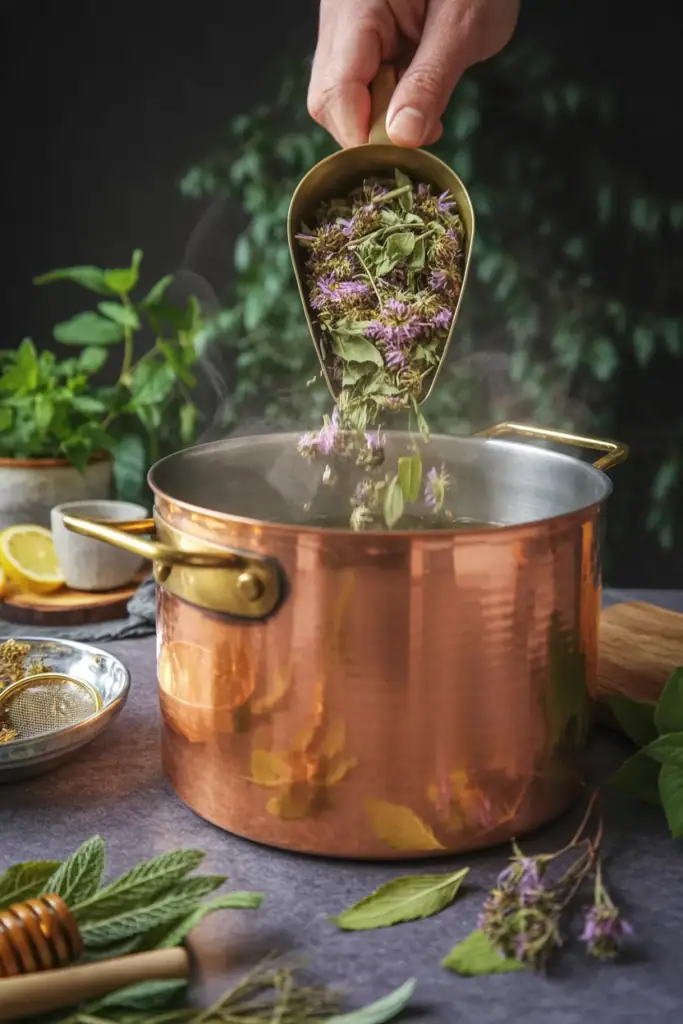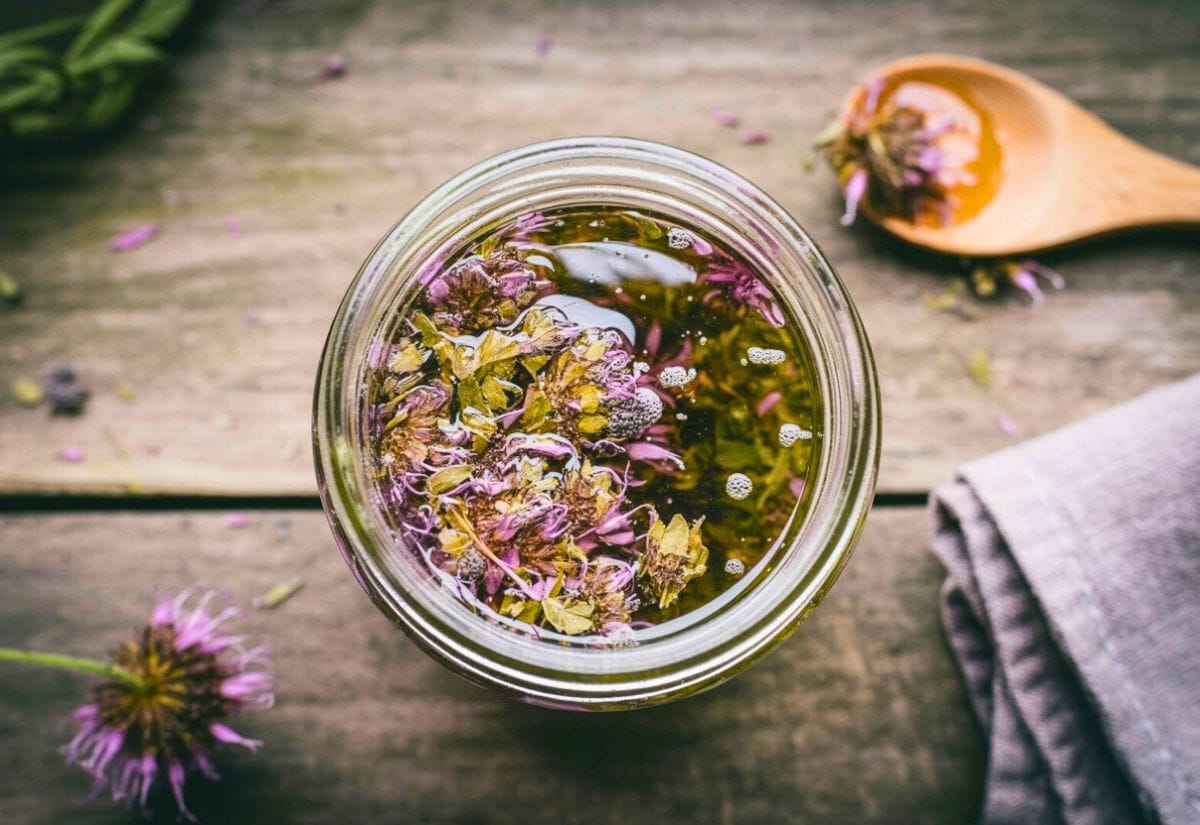So… I’ve fallen down a rabbit hole. Again. This time it’s bee balm (Monarda fistulosa) — you might know it as wild bergamot or horsemint — and oh wow, this plant is doing the most.
I planted it because, honestly, the flowers looked like tiny fireworks.
But then the bees showed up. Then the butterflies. Then hummingbirds. My garden turned into a pollinator party, and I was not mad about it.
But here’s where it gets good: it’s not just pretty. It’s useful. Like, slap-it-on-a-burn, stir-it-in-your-tea, make-an-oxymel-and-feel-fancy useful. And the best part? It smells amazing while doing it.
If you’ve got bee balm growing — or even if you’re just curious — I pulled together my favorite ways to use bee balm leaves and blooms that actually make sense.
Benefits of Bee Balm

Bee balm (Monarda spp.), particularly M. fistulosa and M. didyma, is a member of the mint family known for its high thymol content, a compound with strong antiseptic, antibacterial, antifungal, and antiviral properties. It also contains other beneficial compounds like carvacrol, eugenol, and linalool, which contribute to its antimicrobial and anti-inflammatory effects.
Traditionally used for respiratory issues, bee balm helps relieve congestion and cough when taken as a tea or inhaled in steam form. It acts as a carminative for digestive discomfort, easing gas, bloating, and mild stomach upset. Applied topically, it supports wound healing and helps treat fungal infections.
Its mild calming effects make it useful for nervous tension, and a strong infusion can be used as a natural mouthwash for sore throats, gum issues, and mouth sores. Modern studies support many of these traditional uses, confirming its value in respiratory, digestive, and dermatological care.
1. Bee Balm Salve

This one’s a must-have for gardeners, hikers, or anyone with skin that sees real use. To make a healing salve, infuse bee balm leaves and flowers in a carrier oil, then melt and blend with beeswax. The result is a soft, spreadable balm with natural antiseptic and anti-inflammatory properties. Apply to cuts, scrapes, minor burns, or fungal spots — it’s a gentle, effective way to support your skin without the synthetic additives.
2. Bee Balm Tea

On a cool, gray afternoon, nothing hits quite like a cup of bee balm tea. Steep the flowers and leaves — fresh or dried — for about 10 minutes, and you’ll get a rich, ruby-red brew with notes of citrus and spice. The flavor lands somewhere between Earl Grey and thyme, with a soft, warming kick. Traditionally, this tea has been used to soothe digestion, ease cold symptoms, and calm the nerves. Whether you’re under the weather or just winding down after a long day, this cup brings comfort and color.
3. Bee Balm Steam

Feeling stuffed up from allergies or the start of a cold? A bee balm steam can work wonders. Add a generous handful of fresh or dried bee balm leaves to a bowl of just-boiled water, lean in close, and tent a towel over your head to trap the steam. Breathe deeply for several minutes. The aromatic vapors — minty, slightly sharp, and unmistakably herbal — help open the sinuses, soothe inflamed passages, and ease congestion.
4. Bee Balm Oxymel

This old folk remedy is having a well-earned revival. An oxymel combines raw honey and apple cider vinegar — both powerful on their own — with fresh bee balm to create a sweet-tart tonic. Let it infuse for a couple of weeks, strain, and keep it on hand for sore throats, colds, and daily immune support. It’s also surprisingly delicious as a salad drizzle or marinade. Think of it as herbal syrup with purpose.
5. Bee Balm Poultice
If you’ve been stung, scraped, or run into a patch of something itchy, bee balm can step in as a quick and effective field remedy. Crush a few fresh leaves with your fingers or a mortar, then press the mash directly onto the affected area. Cover it with a clean cloth or bandage and let the plant do its work. The cooling, anti-inflammatory properties help soothe bug bites, minor burns, rashes, and even muscle twinges.
6. Bee Balm Tincture

This is one of those “long game” remedies — slow to make, but worth the wait. To create a bee balm tincture, simply pack a jar with fresh or dried leaves and flowers, cover with high-proof alcohol (like vodka or brandy), and let it steep in a cool, dark place for several weeks. Strain and store in a dropper bottle. Just a few drops can ease digestive discomfort or help settle nerves on a stressful day.
7: Bee Balm Infused Oil

This is one of the most versatile ways to preserve and use bee balm — a true staple for any home apothecary. To make it, pack a clean jar with fresh or gently wilted bee balm leaves and flowers, then cover with a carrier oil like olive, sunflower, or sweet almond. Let it sit in a warm, sunny window for 2–3 weeks (or longer if using dried plant material), giving it a gentle shake now and then. Once strained, the resulting oil is rich with bee balm’s natural anti-inflammatory and antimicrobial properties. Use it as a base for salves, massage into sore muscles, or apply directly to dry skin, burns, and bug bites. It also makes a beautiful bath oil — a little wild luxury straight from your garden.
8. Bee Balm Mouthwash
Gentle yet effective, bee balm makes a refreshing, natural mouthwash. Steep the leaves and flowers in boiling water, allow it to cool, then swish like you would with any rinse. The infusion helps soothe sore throats, reduce gum inflammation, and freshen breath — all without the burn of alcohol-based formulas.
9. Bee Balm Jelly

It might surprise you, but bee balm makes a stunning jelly. Steep the flowers in hot water to make a floral “tea,” then use that infusion as the liquid base in your favorite jelly recipe. The finished spread is delicately sweet, with notes of spice and citrus. Try it on biscuits, scones, or with soft cheeses — it’s a beautiful way to capture the essence of summer.
10. Bee Balm Salad Garnish

Bee balm’s petals bring more than just a splash of color — they carry a gentle citrus-mint flavor that brightens up greens, grains, and pasta salads. Tear the petals or young leaves and scatter them over your dish just before serving. It’s an easy way to add a little wild flavor and make any meal feel fresh from the garden.
11. Bee Balm Vinegar

Fill a jar with fresh bee balm, top it off with apple cider or white balsamic vinegar, and let it steep in a sunny window for a couple weeks. What you get is a tangy, floral vinegar that’s great for dressings, marinades, or even a splash in sparkling water. It also makes your kitchen smell amazing while it’s infusing.
13. Bee Balm Mead
If you’ve ever brewed your own mead — or know someone who does — toss a handful of bee balm into the ferment. It adds this lovely herbal-citrus note that pairs beautifully with the honey. The end result tastes like something you’d sip by a campfire on a warm night, with a bit of wildness in every glass.
14. Bee Balm-Infused Honey

This one’s as delicious as it is healing. To make a simple infused honey, place about 1/4 cup of dried bee balm flowers and the zest of one lemon into a half-pint jar. Pour raw honey over the mix, letting it slowly settle, and stir with a chopstick or butter knife to release any trapped air bubbles. Cap it and set the jar in a sunny window for about two weeks — long enough for the honey to soak up all that bright, citrusy-spice flavor. When ready, you can spoon the flowers off the top or gently warm and strain the honey. Take a spoonful when your throat’s feeling rough, or use it to sweeten teas and herbal infusions. It’s comforting, flavorful, and beautiful to look at. (Note: not recommended during pregnancy.)
15. Bee Balm as Oregano

You might not expect it, but bee balm makes a solid stand-in for oregano — especially when you’re after a slightly brighter, citrusy twist. Just dry the leaves, crumble them up, and sprinkle into soups, sauces, or over roasted veggies and meats. It’s especially good with grilled fish or anything Mediterranean.
16. Bee Balm in Cocktails

If you like playing with flavors, bee balm’s a fun one to bring behind the bar. Muddle the leaves into a gin and tonic, infuse them into a simple syrup, or float the petals in a spritz. It adds a light, herbal-floral note — kind of like mint’s wilder cousin — and makes any drink feel like a garden party.
17. Bee Balm Body Butter

If your skin’s been through a season of sun, wind, or garden grit, bee balm body butter is pure comfort in a jar. Start by infusing bee balm leaves and flowers in a nourishing oil like jojoba, sunflower, or sweet almond. Once strained, melt that infused oil with shea butter and a touch of beeswax, then whip it until fluffy. The result is a rich, creamy butter that sinks into dry skin, leaving behind a subtle herbal scent and long-lasting moisture. Bee balm’s natural antiseptic and anti-inflammatory qualities make this especially helpful for hands, elbows, feet, and anywhere needing a little extra care. It’s a lovely way to carry the essence of summer’s bloom into the colder months.
18. Bee Balm Potpourri

Bee balm holds its color and its scent beautifully when dried, which makes it a natural fit for homemade potpourri. Toss it with dried lavender, rose petals, and some citrus peel for a mix that smells as good as it looks. Tuck it into linen drawers, hang it in the closet, or just set a bowl out on the windowsill — it lifts the space and your mood all at once.
Closing Thoughts
Bee balm is a plant that gives back in spades. It’s beautiful, yes — but it’s also useful in a dozen little ways that make life feel more connected and intentional. Whether you’re brewing a cup of tea, soothing a sting, or just adding a splash of color to dinner, bee balm brings a little wild magic with it. So if you’ve got it growing nearby, go ahead and put it to good use. It’s more than just a flower — it’s an old friend.

